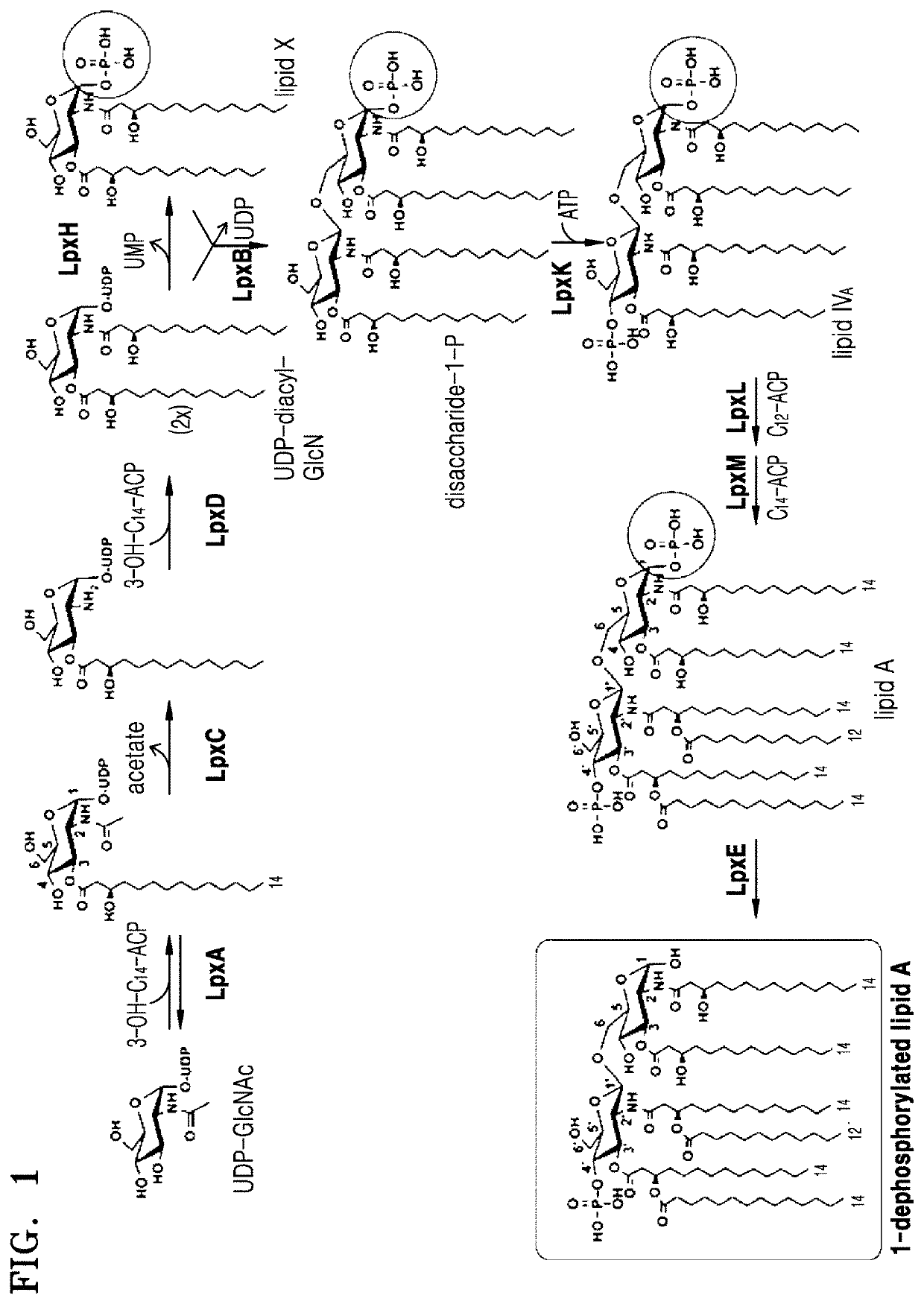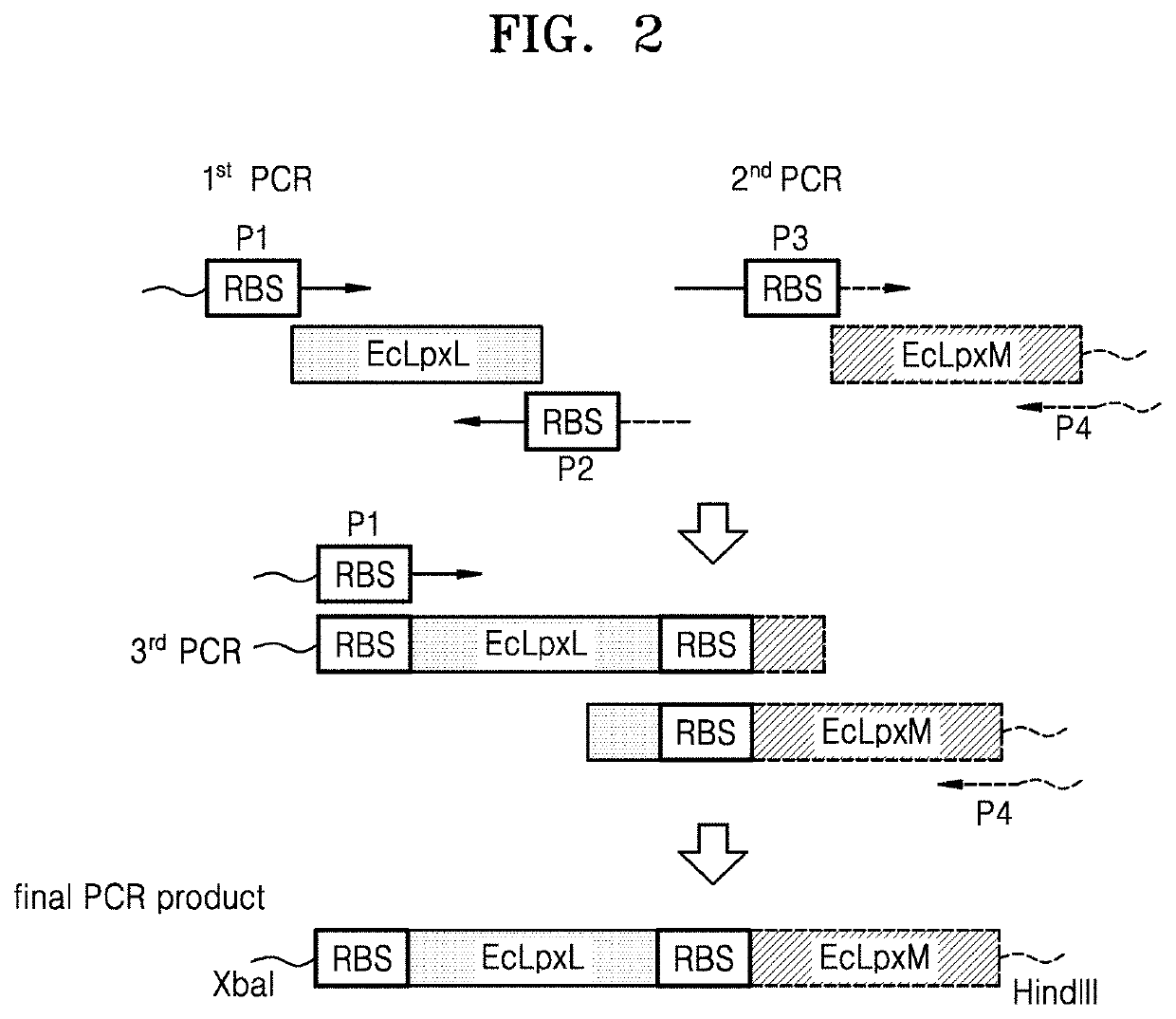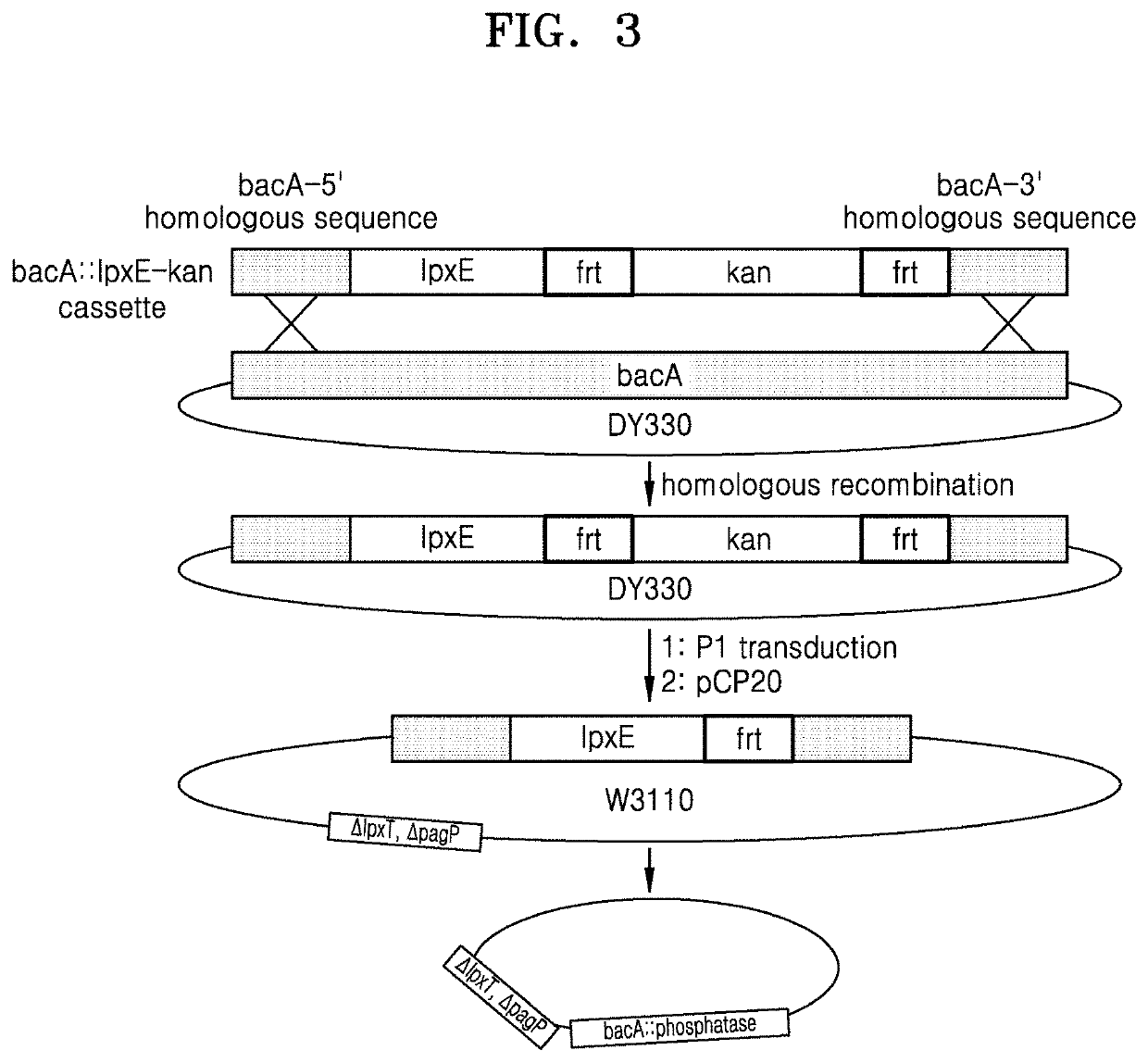Bacterium constitutively producing monophosphoryl lipid A and method of producing monophosphoryl lipid A by using bacterium
a technology of monophosphoryl lipid and bacterium, which is applied in the direction of acyltransferases, enzymology, transferases, etc., can solve the problems of low yield, reduced genetic engineering transformation efficiency and stability, and complicated processes, and achieves high yield.
- Summary
- Abstract
- Description
- Claims
- Application Information
AI Technical Summary
Benefits of technology
Problems solved by technology
Method used
Image
Examples
example 1
on of Vector Including Polynucleotide that Encodes Escherichia coli LpxL and Escherichia coli LpxM
[0061]1.1. Preparation of pWSK29-EcLpxLEcLpxM
[0062]To obtain a polynucleotide that encodes E. coli LpxL polypeptides, from the E. coli W3110 genome (GenBank Accession No. NC_000918.1, ATCC), a polynucleotide (GenBank Accession No. AP009048.1 (c1118159.1117239, SEQ ID NO: 2), which encodes an EcLpxL polypeptide (GenBank Accession No. BAA35852.1, SEQ ID NO: 1) including a ribosome binding site (RBS), was amplified by a first polymerase chain reaction (PCR) using a pair of primers:
[0063]
LpxL forward primer P1:(SEQ ID NO: 3)5′-CGCAGTCTAGAAAGGAGATATATTGATGACGAATCTACCCAAGTTCTC-3′LpxL reverse primer P2:(SEQ ID NO: 4)5′-CGCTATTATTTTTTTTCGTTTCCATTGGTATATCTCCTTCTTATTAATAGCGTGAAGGAACGCCTTC-3′
[0064]To obtain a polynucleotide that encodes E. coli LpxM polypeptides, from the E. coli W3110 genome, a polynucleotide (GenBank Accession No. AP009048.1 (c1941907.1940936, SEQ ID NO: 6), which encodes an EcL...
example 2
on of E. coli Strains
[0088]2.1. Preparation of E. coli KHSC0044 (pWSK29-EcLpxLEcLpxM, ΔlpxT, ΔpagP, bacA::HμLpxE, kdtA::kan, W3110) Strain
[0089]2.1.1 Preparation of E. coli from which lpxT Gene was Removed from Genome
[0090]An E. coli lpxT::kan, W3110 strain was prepared in which a kanamycin cassette is inserted into an lpxT gene (SEQ ID NO: 19) of the E. coli genome, wherein the lpxT gene encodes an LpxT polypeptide (SEQ ID NO: 18).
[0091]Then, a pCP20 plasmid (Kirill A. Datsenko, and Barry L. Wanner PNAS (2000), vol. 97, p. 6640-6645) was transformed into the E. coli lpxT::kan, W3110 strain and the transformed E. coli was then selected on an LB plate. The selected E. coli was inoculated on an LB plate, and selected at a temperature of 42° C., thereby preparing an E. coli ΔlpxT, W3110 strain from which lpxT and the kanamycin cassette were removed.
[0092]2.1.2 Preparation of E. coli from which pagP Gene and lpxT Gene were Removed from Genome
[0093]A P1 phage was prepared from an E. coli...
example 3
tion of Lipid Compositions of E. coli Strains KHSC0044, KHSC31, KHSC0045, and KHSC0055
[0134]3.1 Cultures of KHSC0044, KHSC0031, and KHSC0045
[0135]E. coli strains KHSC0044, KHSC0031, and KHSC0045 were prepared as described above in Section 2.1.6, Section 2.2.3, and Section 2.3.3, respectively.
[0136]A stock of each of the E. coli strains was inoculated on an LB plate containing 50 μg / mL of ampicillin (EMD millipore) and 1 mM of isopropyl β-D-1-thiogalactopyranoside (IPTG) (UBP Bio), and then cultured. KHSC0044 (8 colonies), KHSC0031 (7 colonies), and KHSC0045 (7 colonies) strains were selected, and then each inoculated into 3 mL of an LB liquid medium containing 50 μg / mL of ampicillin (EMD millipore) and 1 mM of IPTG, and then cultured overnight at about 30° C. Each resulting culture solution was inoculated into 200 mL of a fresh) LB liquid medium containing 50 μg / mL of ampicillin and 1 mM of IPTG, diluted to an OD600 of about 0.06 to about 0.1, and then cultured overnight at about 30...
PUM
| Property | Measurement | Unit |
|---|---|---|
| temperature | aaaaa | aaaaa |
| temperature | aaaaa | aaaaa |
| temperature | aaaaa | aaaaa |
Abstract
Description
Claims
Application Information
 Login to View More
Login to View More - R&D
- Intellectual Property
- Life Sciences
- Materials
- Tech Scout
- Unparalleled Data Quality
- Higher Quality Content
- 60% Fewer Hallucinations
Browse by: Latest US Patents, China's latest patents, Technical Efficacy Thesaurus, Application Domain, Technology Topic, Popular Technical Reports.
© 2025 PatSnap. All rights reserved.Legal|Privacy policy|Modern Slavery Act Transparency Statement|Sitemap|About US| Contact US: help@patsnap.com



